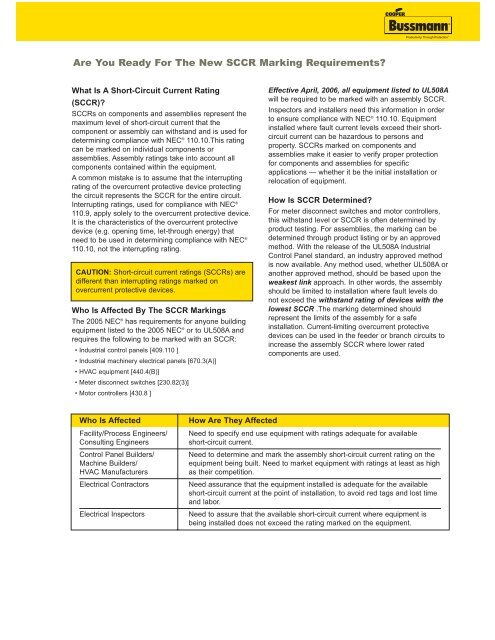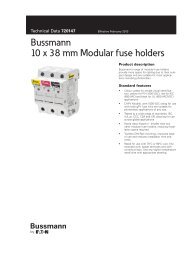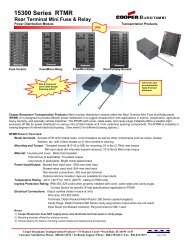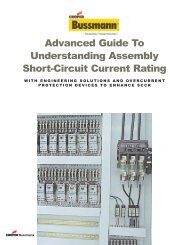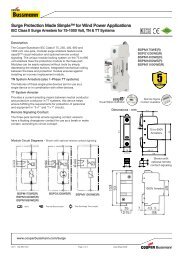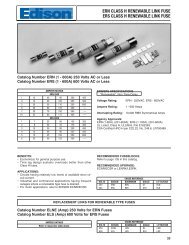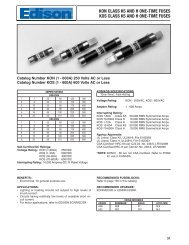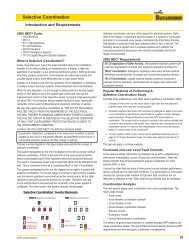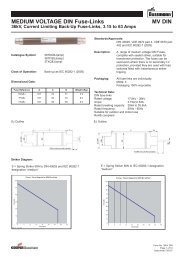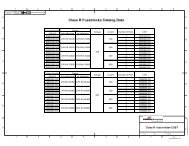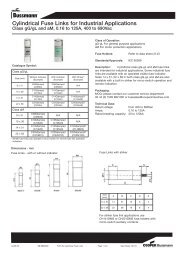Simplified Guide To Understanding Short-Circuit Current Rating
Simplified Guide To Understanding Short-Circuit Current Rating
Simplified Guide To Understanding Short-Circuit Current Rating
You also want an ePaper? Increase the reach of your titles
YUMPU automatically turns print PDFs into web optimized ePapers that Google loves.
Are You Ready For The New SCCR Marking Requirements?What Is A <strong>Short</strong>-<strong>Circuit</strong> <strong>Current</strong> <strong>Rating</strong>(SCCR)?SCCRs on components and assemblies represent themaximum level of short-circuit current that thecomponent or assembly can withstand and is used fordetermining compliance with NEC ® 110.10.This ratingcan be marked on individual components orassemblies. Assembly ratings take into account allcomponents contained within the equipment.A common mistake is to assume that the interruptingrating of the overcurrent protective device protectingthe circuit represents the SCCR for the entire circuit.Interrupting ratings, used for compliance with NEC ®110.9, apply solely to the overcurrent protective device.It is the characteristics of the overcurrent protectivedevice (e.g. opening time, let-through energy) thatneed to be used in determining compliance with NEC ®110.10, not the interrupting rating.CAUTION: <strong>Short</strong>-circuit current ratings (SCCRs) aredifferent than interrupting ratings marked onovercurrent protective devices.Who Is Affected By The SCCR MarkingsThe 2005 NEC ® has requirements for anyone buildingequipment listed to the 2005 NEC ® or to UL508A andrequires the following to be marked with an SCCR:• Industrial control panels [409.110 ]• Industrial machinery electrical panels [670.3(A)]• HVAC equipment [440.4(B)]• Meter disconnect switches [230.82(3)]• Motor controllers [430.8 ]Effective April, 2006, all equipment listed to UL508Awill be required to be marked with an assembly SCCR.Inspectors and installers need this information in orderto ensure compliance with NEC ® 110.10. Equipmentinstalled where fault current levels exceed their shortcircuitcurrent can be hazardous to persons andproperty. SCCRs marked on components andassemblies make it easier to verify proper protectionfor components and assemblies for specificapplications — whether it be the initial installation orrelocation of equipment.How Is SCCR Determined?For meter disconnect switches and motor controllers,this withstand level or SCCR is often determined byproduct testing. For assemblies, the marking can bedetermined through product listing or by an approvedmethod. With the release of the UL508A IndustrialControl Panel standard, an industry approved methodis now available. Any method used, whether UL508A oranother approved method, should be based upon theweakest link approach. In other words, the assemblyshould be limited to installation where fault levels donot exceed the withstand rating of devices with thelowest SCCR .The marking determined shouldrepresent the limits of the assembly for a safeinstallation. <strong>Current</strong>-limiting overcurrent protectivedevices can be used in the feeder or branch circuits toincrease the assembly SCCR where lower ratedcomponents are used.Who Is AffectedFacility/Process Engineers/Consulting EngineersControl Panel Builders/Machine Builders/HVAC ManufacturersElectrical ContractorsElectrical InspectorsHow Are They AffectedNeed to specify end use equipment with ratings adequate for availableshort-circuit current.Need to determine and mark the assembly short-circuit current rating on theequipment being built. Need to market equipment with ratings at least as highas their competition.Need assurance that the equipment installed is adequate for the availableshort-circuit current at the point of installation, to avoid red tags and lost timeand labor.Need to assure that the available short-circuit current where equipment isbeing installed does not exceed the rating marked on the equipment.


